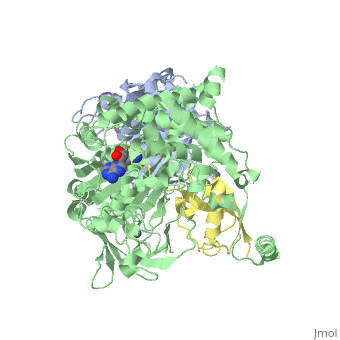3kyc: Difference between revisions
No edit summary |
No edit summary |
||
| Line 1: | Line 1: | ||
==Human SUMO E1 complex with a SUMO1-AMP mimic== | ==Human SUMO E1 complex with a SUMO1-AMP mimic== | ||
<StructureSection load='3kyc' size='340' side='right' caption='[[3kyc]], [[Resolution|resolution]] 2.45Å' scene=''> | <StructureSection load='3kyc' size='340' side='right' caption='[[3kyc]], [[Resolution|resolution]] 2.45Å' scene=''> | ||
| Line 6: | Line 7: | ||
<tr id='related'><td class="sblockLbl"><b>[[Related_structure|Related:]]</b></td><td class="sblockDat">[[3kyd|3kyd]]</td></tr> | <tr id='related'><td class="sblockLbl"><b>[[Related_structure|Related:]]</b></td><td class="sblockDat">[[3kyd|3kyd]]</td></tr> | ||
<tr id='gene'><td class="sblockLbl"><b>[[Gene|Gene:]]</b></td><td class="sblockDat">AOS1, SAE1, SUA1, UBLE1A ([http://www.ncbi.nlm.nih.gov/Taxonomy/Browser/wwwtax.cgi?mode=Info&srchmode=5&id=9606 HUMAN]), HRIHFB2115, SAE2, UBA2, UBLE1B ([http://www.ncbi.nlm.nih.gov/Taxonomy/Browser/wwwtax.cgi?mode=Info&srchmode=5&id=9606 HUMAN]), OK/SW-cl.43, SMT3C, SMT3H3, SUMO1, UBL1 ([http://www.ncbi.nlm.nih.gov/Taxonomy/Browser/wwwtax.cgi?mode=Info&srchmode=5&id=9606 HUMAN])</td></tr> | <tr id='gene'><td class="sblockLbl"><b>[[Gene|Gene:]]</b></td><td class="sblockDat">AOS1, SAE1, SUA1, UBLE1A ([http://www.ncbi.nlm.nih.gov/Taxonomy/Browser/wwwtax.cgi?mode=Info&srchmode=5&id=9606 HUMAN]), HRIHFB2115, SAE2, UBA2, UBLE1B ([http://www.ncbi.nlm.nih.gov/Taxonomy/Browser/wwwtax.cgi?mode=Info&srchmode=5&id=9606 HUMAN]), OK/SW-cl.43, SMT3C, SMT3H3, SUMO1, UBL1 ([http://www.ncbi.nlm.nih.gov/Taxonomy/Browser/wwwtax.cgi?mode=Info&srchmode=5&id=9606 HUMAN])</td></tr> | ||
<tr id='resources'><td class="sblockLbl"><b>Resources:</b></td><td class="sblockDat"><span class='plainlinks'>[http://oca.weizmann.ac.il/oca-docs/fgij/fg.htm?mol=3kyc FirstGlance], [http://oca.weizmann.ac.il/oca-bin/ocaids?id=3kyc OCA], [http://pdbe.org/3kyc PDBe], [http://www.rcsb.org/pdb/explore.do?structureId=3kyc RCSB], [http://www.ebi.ac.uk/pdbsum/3kyc PDBsum]</span></td></tr> | <tr id='resources'><td class="sblockLbl"><b>Resources:</b></td><td class="sblockDat"><span class='plainlinks'>[http://oca.weizmann.ac.il/oca-docs/fgij/fg.htm?mol=3kyc FirstGlance], [http://oca.weizmann.ac.il/oca-bin/ocaids?id=3kyc OCA], [http://pdbe.org/3kyc PDBe], [http://www.rcsb.org/pdb/explore.do?structureId=3kyc RCSB], [http://www.ebi.ac.uk/pdbsum/3kyc PDBsum], [http://prosat.h-its.org/prosat/prosatexe?pdbcode=3kyc ProSAT]</span></td></tr> | ||
</table> | </table> | ||
== Disease == | == Disease == | ||
| Line 33: | Line 34: | ||
==See Also== | ==See Also== | ||
*[[Human SUMO E1 complex with a SUMO1-AMP mimic|Human SUMO E1 complex with a SUMO1-AMP mimic]] | *[[Human SUMO E1 complex with a SUMO1-AMP mimic|Human SUMO E1 complex with a SUMO1-AMP mimic]] | ||
*[[Human SUMO E1~SUMO1-AMP tetrahedral intermediate mimic|Human SUMO E1~SUMO1-AMP tetrahedral intermediate mimic]] | *[[Human SUMO E1~SUMO1-AMP tetrahedral intermediate mimic|Human SUMO E1~SUMO1-AMP tetrahedral intermediate mimic]] | ||
== References == | == References == | ||
<references/> | <references/> | ||
| Line 44: | Line 42: | ||
[[Category: Human]] | [[Category: Human]] | ||
[[Category: Lima, C D]] | [[Category: Lima, C D]] | ||
[[Category: Acetylation]] | |||
[[Category: Acyl-adenylate intermediate]] | [[Category: Acyl-adenylate intermediate]] | ||
[[Category: Adenylation]] | [[Category: Adenylation]] | ||
[[Category: Atp-binding]] | [[Category: Atp-binding]] | ||
[[Category: Cytoplasm]] | |||
[[Category: E1]] | [[Category: E1]] | ||
[[Category: Inhibitor]] | [[Category: Inhibitor]] | ||
| Line 55: | Line 55: | ||
[[Category: Nucleus]] | [[Category: Nucleus]] | ||
[[Category: Phosphoprotein]] | [[Category: Phosphoprotein]] | ||
[[Category: Polymorphism]] | |||
[[Category: Sumo]] | [[Category: Sumo]] | ||
[[Category: Thioester]] | [[Category: Thioester]] | ||
[[Category: Ubiquitin]] | [[Category: Ubiquitin]] | ||
[[Category: Ubl conjugation pathway]] | [[Category: Ubl conjugation pathway]] | ||
Revision as of 11:44, 1 November 2017
Human SUMO E1 complex with a SUMO1-AMP mimicHuman SUMO E1 complex with a SUMO1-AMP mimic
Structural highlights
Disease[SUMO1_HUMAN] Defects in SUMO1 are the cause of non-syndromic orofacial cleft type 10 (OFC10) [MIM:613705]; also called non-syndromic cleft lip with or without cleft palate 10. OFC10 is a birth defect consisting of cleft lips with or without cleft palate. Cleft lips are associated with cleft palate in two-third of cases. A cleft lip can occur on one or both sides and range in severity from a simple notch in the upper lip to a complete opening in the lip extending into the floor of the nostril and involving the upper gum. Note=A chromosomal aberation involving SUMO1 is the cause of OFC10. Translocation t(2;8)(q33.1;q24.3). The breakpoint occurred in the SUMO1 gene and resulted in haploinsufficiency confirmed by protein assays.[1] Function[SAE1_HUMAN] The heterodimer acts as a E1 ligase for SUMO1, SUMO2, SUMO3, and probably SUMO4. It mediates ATP-dependent activation of SUMO proteins followed by formation of a thioester bond between a SUMO protein and a conserved active site cysteine residue on UBA2/SAE2.[2] [3] [4] [5] [6] [7] [8] [SUMO1_HUMAN] Ubiquitin-like protein that can be covalently attached to proteins as a monomer or a lysine-linked polymer. Covalent attachment via an isopeptide bond to its substrates requires prior activation by the E1 complex SAE1-SAE2 and linkage to the E2 enzyme UBE2I, and can be promoted by E3 ligases such as PIAS1-4, RANBP2 or CBX4. This post-translational modification on lysine residues of proteins plays a crucial role in a number of cellular processes such as nuclear transport, DNA replication and repair, mitosis and signal transduction. Involved for instance in targeting RANGAP1 to the nuclear pore complex protein RANBP2. Polymeric SUMO1 chains are also susceptible to polyubiquitination which functions as a signal for proteasomal degradation of modified proteins. May also regulate a network of genes involved in palate development.[9] [10] [11] [12] [SAE2_HUMAN] The heterodimer acts as a E1 ligase for SUMO1, SUMO2, SUMO3, and probably SUMO4. It mediates ATP-dependent activation of SUMO proteins followed by formation of a thioester bond between a SUMO protein and a conserved active site cysteine residue on UBA2/SAE2.[13] [14] [15] [16] [17] [18] Evolutionary Conservation Check, as determined by ConSurfDB. You may read the explanation of the method and the full data available from ConSurf. Publication Abstract from PubMedE1 enzymes activate ubiquitin (Ub) and ubiquitin-like (Ubl) proteins in two steps by carboxy-terminal adenylation and thioester bond formation to a conserved catalytic cysteine in the E1 Cys domain. The structural basis for these intermediates remains unknown. Here we report crystal structures for human SUMO E1 in complex with SUMO adenylate and tetrahedral intermediate analogues at 2.45 and 2.6 A, respectively. These structures show that side chain contacts to ATP.Mg are released after adenylation to facilitate a 130 degree rotation of the Cys domain during thioester bond formation that is accompanied by remodelling of key structural elements including the helix that contains the E1 catalytic cysteine, the crossover and re-entry loops, and refolding of two helices that are required for adenylation. These changes displace side chains required for adenylation with side chains required for thioester bond formation. Mutational and biochemical analyses indicate these mechanisms are conserved in other E1s. Active site remodelling accompanies thioester bond formation in the SUMO E1.,Olsen SK, Capili AD, Lu X, Tan DS, Lima CD Nature. 2010 Feb 18;463(7283):906-12. PMID:20164921[19] From MEDLINE®/PubMed®, a database of the U.S. National Library of Medicine. See AlsoReferences
|
| ||||||||||||||||||||
